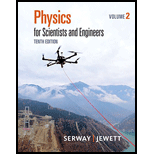
Concept explainers
(a)
The constant friction force for the last
(a)
Answer to Problem 25AP
The constant friction force for the last
Explanation of Solution
The mass of the empty car is
Write the formula to calculate the energy by equation of motion
Here,
The formula of initial kinetic energy is,
Substitute
The formula of kinetic energy at final point
Substitute
The formula of the potential energy at start
Substitute
The formula of the potential energy at final point
Substitute
The formula of the energy wasted due to friction
Substitute
Substitute
Conclusion:
Substitute
Therefore, the constant friction force for the last
(b)
The highest speed reached by the car.
(b)
Answer to Problem 25AP
The highest speed reached by the car is
Explanation of Solution
The formula of kinetic energy at final point
The body is at the lowest point so the resistive force is taken upto that point only.
The formula of the energy wasted due to friction
Substitute
Write the formula to calculate the final velocity from equation (1) can be written as,
Conclusion:
Substitute
Therefore, the highest speed reached by the car is
(c)
The new values of friction force and highest speed when the weight is
(c)
Answer to Problem 25AP
The new value of friction force is
Explanation of Solution
The mass of the empty car is
The Write the formula to calculate the
Substitute
To calculate the final velocity the equation (2)
Substitute
Conclusion:
Therefore, the new value of friction force is
(d)
The depth of the underground part of the ride.
(d)
Answer to Problem 25AP
The depth of the underground part of the ride is
Explanation of Solution
Consider
The formula of the potential energy at start
Substitute
The Write the formula to calculate the depth
Conclusion:
Substitute
Therefore, the depth of the underground part of the ride is
(e)
The depth of the underground provided is feasible or not.
(e)
Answer to Problem 25AP
No, the depth of the underground provided is not feasible.
Explanation of Solution
No the depth of the underground tunnel provided is not feasible as the total length covered by the car is increased due to which the loss of energy due to friction is increased a lot as compared to the case when the underground path was not there. The non-conventional forces on the car are increased due to the depth provided as the friction in the path of later
Conclusion:
Therefore, the depth of the underground provided is not feasible.
Want to see more full solutions like this?
Chapter 8 Solutions
Physics for Scientists and Engineers, Volume 2
- Hi! I need help with these calculations for part i and part k for a physics Diffraction Lab. We used a slit width 0.4 mm to measure our pattern.arrow_forwardExamine the data and % error values in Data Table 3 where the angular displacement of the simple pendulum decreased but the mass of the pendulum bob and the length of the pendulum remained constant. Describe whether or not your data shows that the period of the pendulum depends on the angular displacement of the pendulum bob, to within a reasonable percent error.arrow_forwardIn addition to the anyalysis of the graph, show mathematically that the slope of that line is 2π/√g . Using the slope of your line calculate the value of g and compare it to 9.8.arrow_forward
- An object is placed 24.1 cm to the left of a diverging lens (f = -6.51 cm). A concave mirror (f= 14.8 cm) is placed 30.2 cm to the right of the lens to form an image of the first image formed by the lens. Find the final image distance, measured relative to the mirror. (b) Is the final image real or virtual? (c) Is the final image upright or inverted with respect to the original object?arrow_forwardConcept Simulation 26.4 provides the option of exploring the ray diagram that applies to this problem. The distance between an object and its image formed by a diverging lens is 5.90 cm. The focal length of the lens is -2.60 cm. Find (a) the image distance and (b) the object distance.arrow_forwardPls help ASAParrow_forward
 Physics for Scientists and Engineers: Foundations...PhysicsISBN:9781133939146Author:Katz, Debora M.Publisher:Cengage Learning
Physics for Scientists and Engineers: Foundations...PhysicsISBN:9781133939146Author:Katz, Debora M.Publisher:Cengage Learning College PhysicsPhysicsISBN:9781285737027Author:Raymond A. Serway, Chris VuillePublisher:Cengage Learning
College PhysicsPhysicsISBN:9781285737027Author:Raymond A. Serway, Chris VuillePublisher:Cengage Learning Principles of Physics: A Calculus-Based TextPhysicsISBN:9781133104261Author:Raymond A. Serway, John W. JewettPublisher:Cengage Learning
Principles of Physics: A Calculus-Based TextPhysicsISBN:9781133104261Author:Raymond A. Serway, John W. JewettPublisher:Cengage Learning Physics for Scientists and Engineers with Modern ...PhysicsISBN:9781337553292Author:Raymond A. Serway, John W. JewettPublisher:Cengage Learning
Physics for Scientists and Engineers with Modern ...PhysicsISBN:9781337553292Author:Raymond A. Serway, John W. JewettPublisher:Cengage Learning Physics for Scientists and EngineersPhysicsISBN:9781337553278Author:Raymond A. Serway, John W. JewettPublisher:Cengage Learning
Physics for Scientists and EngineersPhysicsISBN:9781337553278Author:Raymond A. Serway, John W. JewettPublisher:Cengage Learning Physics for Scientists and Engineers, Technology ...PhysicsISBN:9781305116399Author:Raymond A. Serway, John W. JewettPublisher:Cengage Learning
Physics for Scientists and Engineers, Technology ...PhysicsISBN:9781305116399Author:Raymond A. Serway, John W. JewettPublisher:Cengage Learning





